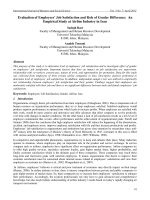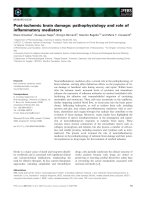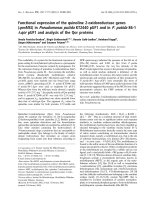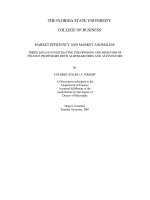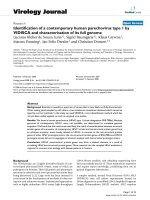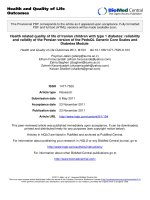Class 1 Development Theories and Role of Finance 2018
Bạn đang xem bản rút gọn của tài liệu. Xem và tải ngay bản đầy đủ của tài liệu tại đây (1.53 MB, 19 trang )
Development Finance, MPP, VJU
Prof. Koji. Fujimoto
4/15/2008
Class 1 1 Development Theories and Role of Finance
DDevelopment theories has have been developed after since World War II andbut have
is not necessarily established established its academic integrity. And,Nevertheless
therefore, it this topic can be discussed, at least, from three different aspects as shown in
Figure 1 below.
As Figure 1 suggests, “development theories” encompasses economic theories and
development theories, which had have been developed in throughout the developed
world, and represent developmental problems and issues that LDCs often confront, and
development approaches/strategies that the donor community usually invents to tackle
the problems and issues and therefore the LDCs, exercise.
To grasp obtain the a bird-eyes picture view of development theories, it is
worthwhile to reviewing them in chronological order.
Figure 1 1 Development Economics and Development Theories
Conventional Economic
Theories (incl. Economic
Growth Theories)
Development Theories (incl.
Development
Economics)
Various Development
Issues/Problems in the
LDCs
1
Development Finance, MPP, VJU
Prof. Koji. Fujimoto
Development Policies and
Approaches/Strategies
Employed in throughout
the World
1. Development Theories in the ‘1940s and ‘950s
(1) Harrod-Domar Growth Model
In the West, economic theory of growth was developed in its simplest way form
by using the following formula.
ΔY/Y = I/Y × ΔY/I = I/Y ÷ ΔK/ΔY,
where I/Y is Investment Ratio and, ΔK/ΔY or I/ΔY is Incremental Capital
Output Ratio (ICOR). ICOR measures the increment in capital required in
order to produce an additional $1 worth of output. A large ICOR value is not
preferred to because it indicates that the economy is inefficient.
The above formula is understood as follows as well.
Growth Rate of GDP (g) = Investment Ratio × Inverse Ratio of ICOR
= Investment Ratio ÷ ICOR,
in other expressions,
ICOR = I/Y ÷ g = Investment Ratio/Growth Rate of GDP
The Harrod-Dormer Growth Model claims that in the closed economy
‘Investments’ are financed by ‘Savings’, and, therefore, the maximum economic
growth rate can only be attained by utilizing savings fully.
2
Development Finance, MPP, VJU
Prof. Koji. Fujimoto
(2) The Big Push (Balanced Growth) by Rosenstein-Rodan
Rosenstein-Rodan argued for a “big push”:
The theory of growth is very largely a theory of investment.…. “….A
minimum quantum of investment is a necessary condition for successful
development. . . ….Launching a country into self-sustaining growth is a
little like getting an airplane off the ground. There is a critical ground speed
which must be passed before the craft can become airborne. . .…. ……A big
push seems to be required to jump over the economic obstacles to
development.” There may be finally a phenomenon of indivisibility in the
vigor and drive required for a successful development policy. Isolated and
small efforts may not add up to to a sufficient impact on growth. An
atmosphere of development may only arise with a minimum speed or
investment size of investment.
The essence of the argument for a big push is that various investment
decisions are not independent and have high risks because of the uncertainty about
whether their products will find a market. But On the other hand, if an investment
occurs on a wide front, then what is may not become true in the case of a single
investment project will become true for the complementary system of many
investment projects: the new producers will be each other’s customers, and the
complementarity of demand will reduce the risk of not finding a market.
Simultaneous industrialization of many sectors of the economy could be profitable
for them all, even though independently no one sector would be profitable
industrializing alone. Governments therefore needs to coordinate activities in under
a broadly based investment program to “jump” over the economic obstacles to
development.
(3) The Vicious Circle of Poverty by Ragnar NurkseNurkse
“A poor man may not have enough to eat; being underfed, his health may be weak;
being physically weak, his work capacity is low, which means that he is poor,
which in turn means that he will not have enough to eat; and so on.” A situation of
3
Development Finance, MPP, VJU
Prof. Koji. Fujimoto
this sort, relating to a country as a whole, can be summed up in the trite proposition:
“a country is poor because it is poor.” (See Biography of A Subject, p.62)
The supply of capital is governed by the ability and willingness to save; the demand
for capital is governed by the incentives to invest. A circular relationship exists on
both sides of the problem of capital formation in the poverty-ridden areas of the
world.
On the supply side, there is the small capacity to save, resulting from the low
level of real income. The low real income is a reflection of low productivity, which
in its turn is due largely to the lack of capital. The lack of capital is a result of the
small limited capacity to save, and so the circle is complete.
On the demand side, the inducement to investment may be low because of
the small limited buying power of the people, which is due to their limitedsmall real
income, which again is due to low productivity. The low level of productivity,
however, is a result of the limitedsmall amount of capital used in production, which
in its turn may be caused at least partly by the limitedsmall inducement to invest.
The iImplication of the Vicious Circle of Poverty Model is the Balanced
Growth Approach in development. And, as a matter of fact, Nurkse’s analysis of
capital accumulation puts its the emphasis on “balanced growth.”
(4) Two-Sector Model by William Arthur Lewis
This model is one of the best known and, therefore, the most important development
development theories that students of development studies have to learn. The Lewis
two-sector model, originally developed in the mid-1950s’50s, became the general
theory of the development process in surplus-labor Third World nations during most
of the 1960s ‘60s and through the early ‘1970s.
(The attached excerpt from Todaro’s Economic Development Tenth Edition pp.115118
(pp.84~87)explains the Lewis Model.)
(5) Stages of Economic Growth Model by Walt Whitman Rostow
4
Development Finance, MPP, VJU
Prof. Koji. Fujimoto
Under the circumstances of a sterile intellectual environment, fueled by the cold
war politics of the 1950s ‘50s and 1960s’60s, Rostow’s “Stages of Growth Model ”
appealed to scholars, politicians, and administrators alike.
Rostow focused on change through “five stages” in modern economies, as he
wrotewriting in the opening chapter of The Stages of Economic Growth:
“This book presents an economic historian’s way of generalizing the sweep
of modern history… . . . ….. It is possible to identify all societies, in their
economic dimensions, as lying within one of five categories: the traditional
society, the pre-conditions for take-off into self-sustaining growth, the take-off,
the drive to maturity, and the age of high mass consumption.”…..
The Traditional Society
The economy is dominated by subsistence activity. Output is consumed by producers;
it is not traded. Trade is barter where goods are exchanged directly for other goods.
Agriculture is the most important industry. Production is labor intensive using only
limited quantities of capital. Technology is limited, and resource allocation is
determined vary much by traditional methods of production.
The Pre-conditions for Take-off
Increased specialization generates surpluses for trading. There is an emergence of a
transport infrastructure to support trade. Entrepreneurs emerge as incomes, savings,
and investment grow. External trade also occurs concentrating on primary
products. A strong central government encourages private enterprises.
The Take-off
The “take-off” is defined as requiring all three of the following conditions: (i) a
rise in the rate of productive investment from, say, 5% percent or less to over 10%
percent of the national income; (ii) the development of one or more substantial
manufacturing sectors, with a high rate of growth; and (iii) the existence or quick
emergence of a political, social, and institutional framework that exploits the
impulses to expansion in the modern sector and the potential external economy
effects of the take-off and that gives to growth an ongoing character. The prospect
of the take-off suggested the possibility that developing nations would eventually
5
Development Finance, MPP, VJU
Prof. Koji. Fujimoto
move to self-sustained growth, and foreign external aid would no longer be
required.
(Excerpted from Meier’s Biography of A Subject and Todaro’s Economic
Development)
The Drive to Maturity
The economy is diversifying into new areas. Technological innovation is providing a
diverse range of investment opportunities. The economy is producing a wide
range of goods and services and there is less reliance on imports. Urbanization
increases. Technology is used widely.
The Age of High Mass Consumption
The economy is geared towards mass consumption, and the level of economic
activity is very high. Technology is extensively used but its expansion slows. The
service sector becomes increasingly dominant. Urbanization is complete. Now,
multinationals emerge. Income for large numbers of persons transcends basic
food, shelter and clothing. Increased interest in social welfare.
2. Development Theories from the Late ‘1950s throughout the ‘1960s
(1) Unbalanced Growth by A.O. Hirschman
Hirschman criticized the balanced growth doctrine by saying “If a country were
ready to apply the doctrine of balanced growth, then it would not be
underdeveloped in the first place.”
Hirschman argues for a strategy of unbalanced growth that would promote a
few key sectors with forward and backward linkages that would create
disequilibrium and then induce decisions in other sectors to correct the
disequilibrium. An industry creates a backward linkage when it demands inputs
from an upstream industry. Forward linkages reduce the costs of downstream users
of the investment’s products and ease their supply.
(2) The Vent-for-Surplus Theory of International Trade by Hla Myint
The assumption of full employment in traditional trade models, like that of the
6
Development Finance, MPP, VJU
Prof. Koji. Fujimoto
standard perfectly competitive equilibrium model of microeconomic theory violates
the reality of unemployment and underemployment in developing nations. A
conclusion could be drawn from the recognition of widespread unemployment in
the Third World. This conclusion is that underutilized human resources create the
opportunity to expand productive capacity and GNP at little or no real cost by
producing for export markets products that are not demanded locally. This is known
as the vent-for-surplus theory of international trade. First formulated by Adam
Smith, it has been expounded more recently in the context of developing nations by
Hla Myint.
( The attached excerpt from Todaro’s Economic Development Tenth Edition (pp.
609~610) explains the Vent-for-Surplus Theory of International Trade vis-à-vis
development of the developing countries.)
(3) Two-Gap Model by H. B. Chenery and M. Bruno
This model is based on a structuralist concept of development and incorporates
explicit limits on the rate of increase of domestic saving, investment, and exports.
The model focuses in particular on the savings and foreign exchange constraints to
development. The shortage of domestic savings limits the capital accumulation in
the developing country. The shortage of foreign exchange limits the country’s
capacity to import. If the growth in GNP depends on the importation of goods that
cannot be produced at home, then the country’s growth rate will be constrained by
its access to foreign exchange. T, these two gaps, -the savings gap and the foreign
exchange gap,- might be filled by foreign aid.
It might be thought that, according to neoclassical analysis, an increase in
domestic savings should also relax the foreign exchange constraint through the
release of resources for imports-substitute industries for necessary imports, and
exports may confront a highly inelastic demand.
The foreign exchange constraint could bite before the savings constraint. The
“two-gap model then become a “financing gap” model that claimed claims to show
the high potential productivity of foreign aid in providing exchange and thereby
enabling otherwise redundant domestic savings to be used in investment (Chenery
and Bruno; Chenery and A. Strout).
7
Development Finance, MPP, VJU
Prof. Koji. Fujimoto
The gap between required and available savings and between required and
available foreign exchanges can be filled by an inflow of foreign loans and/or
grants from governments in of rich wealthy countries. The inflow of public foreign
capital is equivalent to an inflow of savings from abroad: wealthy the rich countries
transfer their savings to investment opportunities in the poor poor countries. By
relaxing the savings and foreign exchange constraints, the inflow of foreign capital
can yield an increase in national income that is several times the cost of the foreign
loan.
The This model can be explained in terms of macro-economic equations (the
Output Approach and the Expenditure Approach).
Y = C + I + (X – M) ---------------------------------------- (1)
where Y is GNP, C is Consumption, I is Investment, X is Exports and M is
Imports.
The equation (1) can be rewritten as
Y + M = C + I + X -------------------------------------------- (2)
The left side of the equation (2) shows availability of domestic resources and the
right side shows uses of domestic resources.
From the distribution side (the Income Approach),
Y = C + S ------------------------------------------------------- (3)
where S is Saving.
From the equation (2) and (3), we can obtain
M – X = I – S -------------------------------------------------- (4)
The left side is the foreign exchange gap and the right side is the savings gap. The
equation (4) shows that the foreign exchange gap is equivalent to the savings gap
on an ex-post basis. In other words, it is not guaranteed that the equality holds on
to an ex-ante basis.
(4) Economic Growth Approach (International Development Approach)
After WW II, to aid war-torn Western Europe the Marshall Plan (European Recovery
Program), which lasted for 4 years from 1948~51, of the U.S. was implemented.
The European economies were reconstructed and economic growth of those
countries resumed. Success of the aid program was largely attributable to
8
Development Finance, MPP, VJU
Prof. Koji. Fujimoto
reconstruction of physical economic infrastructure. Subsequently, the U.S. and the
World Bank initiated to help develop the Third World by concentrating their aid on
economic infrastructure development, believing that infrastructure development
would result in successful economic development of developing countries. This
approach of aid can be characterized as the Economic Growth Approach.
3. Development Theories in 1970s the ‘70s throughout 1980sthe ‘80s
(1) Dependency (Dependence) Model
During the 1970s’70s, international-dependency models gained increasing
support, especially among Third World intellectuals, as a result of growing
disenchantment with both the ‘stages’ and ‘structural-change’ models. Essentially,
international dependency models view developing countries as beset by
institutional, political, and economic rigidities, both domestic and international,
caught up in a dependence and dominance relationship with wealthierrich countries.
The dependency model is an indirect outgrowth of Marxist thinking. It
attributes the existence and continuance of underdevelopment primarily to the
historical evolution of a highly unequal international capitalist system of
wealthyrich countryy- poor less wealthy country relationships. Whether because
wealthyrich nations are intentionally exploitative or unintentionally neglectful, the
coexistence of wealthyrich and poor nations in an international system dominated
by such unequal power of relationships between the center (the developed
countries) and the periphery (the LDCs) renders attempts by poor nations to be selfreliant and independent difficult and sometimes even impossible. Certain groups in
developing countries (including landlords, entrepreneurs, military rulers, merchants,
salaried public officials, and trade union leaders) who enjoy high incomes, social
status, and political power constitute a small elite ruling class whose principal
interest is in the perpetuation of the international capitalist system of inequality and
conformity by which they are rewarded. Directly and indirectly, they serve (are
dominated by) and are rewarded by (are dependent on) international special-interest
power groups including multinational organizations such as the World Bank and
IMF, which are tied by allegiance or funding to the wealthy capitalist countries. The
9
Development Finance, MPP, VJU
Prof. Koji. Fujimoto
elites’ activities and viewpoints often serve to inhibit any genuine reform efforts
that might benefit the wider population and in some cases actually lead to even
lower levels of living and to the perpetuation of underdevelopment. In short, the
neo-Marxist/neocolonial view of underdevelopment attributes a large part of the
Third World’s continuing and worsening poverty to the existence and policies of the
industrial capitalist countries of the Northern Hemisphere and their extensions in
the form of small but powerful elite or comprador groups in the less developed
countries. Underdevelopment is thus seen as an externally induced phenomenon, in
contrast to the linear-stages and structural-change theories’ stress on internal
constraints such as insufficient savings and investment or lack of education and
skills. Revolutionary struggles or at least major restructuring of the world capitalist
system are therefore required to free dependent Third World nations from the direct
and indirect economic control of the developed world and domestic oppressors.
(See Todaro’s Tenth Edition, pp.122~124)
Dependency relationships are said to be found, in the Third World, in a
variety of forms such as “foreign capital,” “elites in LDCs,” “technologies of
industrialized countries,” “terms of trade” and “cultural, social and institutional
factors.”
In 1974, the UN Special Assembly resolved “New International Economic Order:
NIEO.” This was the united demand of the Third World to the industrialized
countries, though it was not put into practice and effect.
(2) Neo-classical Approach (Neo-classical Economic Growth Theory) by Robert M.
Solow
A cornerstone of the neoclassical free-market argument is the assertion that
liberalization of national markets draws additional domestic and foreign
investment and thus increases the rate of capital accumulation. In terms of GNP
growth, this is equivalent to raising domestic savings rates, which enhances
capital-labor ratios and per capita incomes in capital-poor developing countries.
Traditional neoclassical models of growth are a direct outgrowth of the HarrodDomar (R.F. Harrod & E.D. Domar) and Solow models, which both stress the
10
Development Finance, MPP, VJU
Prof. Koji. Fujimoto
importance of savings.
The Solow neoclassical growth model in particular represented the seminal
contribution to the neoclassical theory of growth and later earned the Nobel Prize
in economics. It expanded on the Harrod-Domar formulation by adding a second
factor, labor, and introducing a third independent variable, technology, to the
growth equation. Unlike the fixed-coefficient, constant-return-to-scale assumption
of the Harrod-Domar model, Solow’s neoclassical growth model exhibited
diminishing returns to labor and capital separately and constant returns to both
factors jointly. Technological progress became the residual factor explaining longterm growth, and its level was assumed by Solow and other growth theorists to be
determined exogenously, this that is, independently of all other factors.
More formally, the Solow model used the standard aggregate production
function in which
Y = A K αL1-α,
where Y is gross domestic products, K is the stock of physical capital, L is the
stock of labor, A is the “technical change” or “total factor productivity (TFP).
“α” represents the elasticity of output with respect to capital (the percentage
increase in GDP resulting from a 1% increase in capital).
It isThis function is usually measured statistically as the share of capital in a
country’s national income accounts. Since α is assumed to be less than 1 and
private capital is assumed to be have paid its marginal product so that there are no
external economies, this formulation of neoclassical growth theory yields
diminishing returns to capital and labor.
When the production function above is differentiated by time factor, it is
shown as below.
△Y/Y = △A/A + α ×△K/K + (1-α) ×△L/L
where △Y/Y is the national income growth rate, △A/A is the rate of
technological improvement, α is the share of capital in national income, △K/K
is the capital growth rate, (1-α) is the share of labor in national income and
△L/L is the labor growth rate.
According to the neoclassical growth theory, output growth results from
one or more of three factors: increases in labor quantity and quality (through
population growth and education), increases in capital (through investment), and
11
Development Finance, MPP, VJU
Prof. Koji. Fujimoto
improvements in technology. Closed economies (those with no external activities)
with lower savings’ rates (other things being equal) grow more slowly in the short
run than those with high savings’ rates and tend to converge to lower per capita
income levels. Open economies (those with trade, foreign investment, etc.),
however, experience income convergence at higher levels as capital flows from
wealthierrich countries to poor countries where capital-labor ratios are lower and
thus returns on investments are higher. Consequently, by impeding the inflow of
foreign investment, the heavy-handedness of LDC governments, according to
neoclassical growth theory, will retard growth in the economies of the Third
World. (Todaro’s Tenth Edition pp.128-129, pp147-150)
(3) Basic Human Needs (BHN) Approach (International Development Approach)
The Economic Growth Approach to economic development of LDCs, which had
been practiced during 1950s the ‘50s and 1960sthe ‘60s, was reviewed and
evaluated by the World Bank. It is, then, learned that the Economic Growth
Approach was not so successful as anticipated. It was observed that there were
quite a large number of people who were left behind from the economic
development and were further impoverished. In other words, the Trickle-down
Hypothesis was refuted empirically to a considerable degree.
Against this fact, the World Bank and other international aid organizations
such as ILO developed a new development approach called “Basic Human Needs
Approach.”
In essenceBasically, basic needs mean the elementary conditions of
existence for every human being. Basic necessity must then mean the irreducible
minimum prerequisite for a human being. Broadly it further means that it is
indispensable for lying living human life within a society as an equal at last
principle. The “basic needs approach” to development policy sets as priority goals
the progressive expansion of development opportunities (ideally, to reach full
employment in developing countries by the year 2000) and the fulfillment of at
least the minimum family requirements for food, shelter, and clothing and of local
community requirements for such services as pure drinking water, sanitation, public
transportation, and educational and cultural facilities. Emphasis in development
policy is, thus, shifted from aggregate economic targets to the personal need of the
12
Development Finance, MPP, VJU
Prof. Koji. Fujimoto
members of local populations. (ILO, World Employment Conference, 1976)
In addition, the World Bank selected Basic Human Needs (BHN) as the
theme of the 1978 World Development Report and recommended five BHN sectors:
nutrition, health, education, water and sanitation and housing. As a matter of
course, the World Bank as well as other multilateral and bilateral donors
concentrated their support to develop these sectors during the ‘1970s.
(4) Structural Adjustment Approach (International Development Approach)
The second oil shock, which occurred in 1978’78/79, caused developing
countries to face an abrupt increase in oil prices that added to their oil import bills
and affected industrial goods the imports of industrial goods. There was also a huge
increase in interest rates caused by the industrialized countries’ economic
stabilization policies and a decrease in LDC export earnings resulting from a
combination of slowed growth in the more developed nations and a precipitous
decline for of over 20% in primary commodity export prices. Moreover, developing
countries inherited from the previous period a huge debt and debt-service
obligation, which was made even more onerous by the burgeoning interest rates and
more precarious as a result of the bunching of short-term maturities.
The World Bank quickly responded to this serious situation and introduced
what we is now referred to as the call “Structural Adjustment Loan (SAL).” SAL is
a new type of program loan which is disbursed against LDC’s macro-economic
policy reforms from a viewpoint of its long-term economic development
perspective. SAL, therefore, sets three kinds of core conditionalities: (i)
liberalization of foreign exchange, (ii) liberalization of interest rate, and (iii)
liberalization of prices. Conditionalities are not only limited to these three
liberalizations, but also closely related to specific reforms of economy as shown in
Table 1 below.
Table 1 World Bank’s SAL Conditionalities
Policies and Areas of
Conditionalities
13
Development Finance, MPP, VJU
Prof. Koji. Fujimoto
Reforms
1. Trade and Foreign
Exchange Policies
* Devaluation of Foreign Exchange
2. Public Expenditure
and Investment
Program
* Reduction of Public Expenditure (ex. Reduction of Public
Sector Employees)
* Import Tariff Reduction and Simplification
* Reduction of Subsidies/Price Hike of Public Utilities (ex.
Beneficiaries to Pay)
* Re-examination of Public Investment Program
3. Liberalization of
Prices
* Introduction of Market Pricing Mechanism
4. Mobilization of
Domestic
Resources
* Downsizing and Streamlining of State Enterprise Sector
5. Budgetary Revenue
Increase
* Introduction of General Excise Tax
* Abolishment of Controlled Prices
* Strengthening of Banking Institutions
* Liberalization of Interest Rates (Positive Interest Rates)
* Strengthening of Taxation Base
4. Development Theories in 1990sthe ‘90s
(1) Endogenous Growth Theory by P.M. Romer
In endogenizing technological progress, Paul Romer focuses on production
functions that yield increasing returns to scale by technical change and by positive
externalities to capital accumulation. In contrast to Solow’s model, Romer’s
analysis postulates imperfect competition, endogenous technological progress based
on ideas and innovations that come from private provision, differences in
technology across countries, a possible increases in the marginal product of capital
through external effects, and increasing returns to scale at the level of the economy.
Romer wants to recognizes two features of growth that are not endogenized
in the Solow analysis, namely: (i) “the aggregate rate of technological advance is
determined by things that people do,” and (ii) “many individuals and firms have
market power and earn monopoly rents on discoveries.” Endogenous technical
change in Romer’s analysis takes the form of R&D-yielding innovations by
14
Development Finance, MPP, VJU
Prof. Koji. Fujimoto
imperfectly competitive firms that result in new products, new processes, and a
greater variety of capital goods.
According to Romer, whereas a Solow-type growth theory explains growth
in terms of two basic types of factors – technology and conventional inputs –, “new
growth theory… ….. divides the world into two fundamentally different types of
productive inputs that we can call ‘ideas’ and ‘things.’ Ideas are non-rival goods…
…. Things are rival goods… …. Ideas are goods that are produced and distributed
just as other goods are.,” Ideas may be expensive to develop, but as public goods
they are inexpensive to use.
Ideas are thus the primary source of growth. Knowledge-producing activities
are central to growth theory. Knowledge or information, once obtained, can be used
repeatedly with little or no additional cost. Because the new production processes
and products create spillover benefits to other firms and various complementarities,
aggregate investment in the public stock of knowledge exhibits increasing returns to
scale, persists indefinitely, and sustains long-run growth in per capita income.
(Meier’s Biography of A Subject, pp. 98 and 99)
(2) Human Development Approach by UNDP vis-à-vis Capability Approach by Amartya
K. Sen (International Development Approach)
Based on the capability approach developed by Sen, UNDP (Dr. Mahbub ul
Haq) developed the Human Development Approach. The capability approach is the
conceptual framework for evaluating social states in terms of human well-being
(not quite welfare). It emphasizes that the objective of development, and therefore
development itself is to upgrade “human capability.” When the human capability is
upgraded, he or she can enlarge expand the opportunities in which to choose from.
The fact that he/she can choose what he/she wants out of a large number of choices
means that he/she upgrades a their state of “well-being.”
Dr. Haq of UNDP developed the capability approach into the human
development approach by developing the Human Development Index in the first
Human Development Report published in 1990 by UNDP. It can be said that the
human development approach is the first step to translate the conceptual approach
into the practical approach in terms of actual methods of development and
15
Development Finance, MPP, VJU
Prof. Koji. Fujimoto
development cooperation. Owing to the human development approach,
considerable aid resources have been diverted into projects of human priority
concerns such as basic education, primary health care, safe drinking water, adequate
sanitation, family planning and nutrition programs.
“Human beings are born with certain potential capabilities. The purpose of the
development is to create an environment in which all people can expand their
capabilities, and opportunities can be enlarged for both present and future
generations. The real foundation of human development is universalism in
acknowledging the life claims of everyone…….. . . … Wealth is important for
human life. But to concentrate on it exclusively is wrong for two reasons. First,
accumulating wealth is not necessary for the fulfillment of some important
human choices……. . .…. Second, human choices extend far beyond
economic well-being.” (Excerpted from the opening chapter of Human
Development Report 1994)
(3) Poverty Reduction Strategy Approach by the World Bank vis-à-vis Comprehensive
Development Framework (International Development Approach)
In October 1998, James D. Mr. Wolfensohn (then, the president of the World
Bank) proposed the a Comprehensive Development Framework CDF), which
encompasses a set of principles to guide development and poverty reduction,
including the provision of external assistance. The four CDF principles are: (i)
Long-term, holistic vision, (ii) Country ownership, (iii) Country-led partnership and
(iv) Results focus. The four principles do not describe a blueprint by which
countries develop or a specific process by which the Bank provides development
assistance. They are the principles that taken as a whole, underpin and guide all of
the World Bank’s work. (Appendix 1 CDF Matrix and Appendix 2 CDF for Bolivia)
The CDF principles have been underpinning the Poverty Reduction Strategy
Paper (PRSP) process since its inception, and were formally endorsed as the basis
for all of the World Bank’s work.
The PRSP is, in fact, a comprehensive medium-term development plan
whose paramount objective is “Poverty Reduction.” The PRSP is formulated by the
16
Development Finance, MPP, VJU
Prof. Koji. Fujimoto
initiatives of developing countries in line with CDF. All the HIPCs and IDA
countries are required to formulate the PRSP in order to receive debt reduction and
financial assistance of from the World Bank and IMF.
†
17
Development Finance, MPP, VJU
Prof. Koji. Fujimoto
18
Development Finance, MPP, VJU
Prof. Koji. Fujimoto
✍
19
